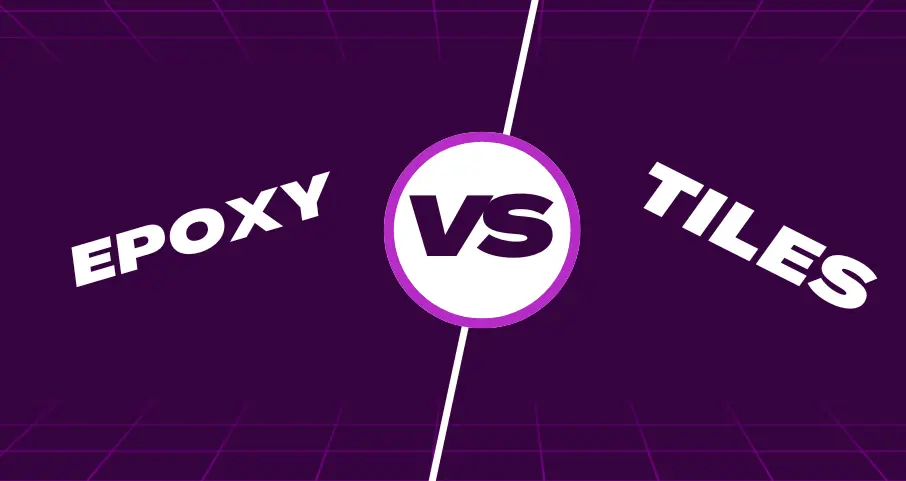Choosing the right flooring is very important as it creates the first impression whether it is a living room or a business showroom. From the available options, it often narrows down to a choice between epoxy flooring and tiles. Both are great options that boast durability and aesthetic appeal.
But which one will work best for your needs?
In tthis blog, we will compare epoxy with tiles on a number of factors: cost, durability, aesthetics, maintenance, and installation, which can help you make an proper and accurate decision.
What Is Epoxy Flooring?
Epoxy flooring consists of flooring material resulting from an applied resinous coating onto concrete. It generally boasts effectiveness in durability and resistance against stains, chemicals, and wear. Generally, it serves garages, warehouses, and other industrial premises, while nowadays, its use in residences is fast gaining great favor.
What Are Tiles?
Tiles are traditional floorings made of ceramic, porcelain, or natural stone. These are installed one by one and fixed with grout. Tiles are very common in kitchens, bathrooms, and outdoors since they come in a wide variety of styles, and moisture does not easily damage them.
Cost Comparison
Epoxy Flooring:
Initial Costs: The initial installation of epoxy flooring can be a bit cheaper, especially for bigger areas. The cost per square foot is generally lower compared to tiles.
Long-Term Value: Due to the long-lasting nature of epoxy, there are almost no costs of maintenance and replacement after installation; it is hence fairly cost-effective over a long period.
Tiles:
Initial Costs: The prices for tiles depend greatly on material. Ranges can vary between the least expensive. In addition to that, putting tiles involves huge amounts of physical labor, further raising the installation cost.
Long-Term Value: While tiles are durable, most of them require grout repairs or replacements over time, adding to the cost of maintenance.
Durability and Lifespan
Epoxy Flooring:

Resistance to Wear and Tear: Epoxy flooring is made which can withstand heavy traffic, impact, and chemical spills showing less wear.
Longevity: With proper maintenance, epoxy flooring can last almost 10–15 years.
Seamless Surface: The seamless nature of epoxy flooring eliminates weak spots where cracks or damage could occur easily.
Tiles:
Wear and Tear Resistance: Generally, tiles are durable but might crack due to heavy impact.
Lifespan: Tiles can last for decades if maintenance is properly carried out, but grout lines usually need repairs now and then.
Vulnerability: After some time, chips and cracks may appear, and this will be highly probable in areas with heavy traffic.
Aesthetic Appeal and Customization
Epoxy Flooring:
Customization Options: Epoxy can be customized to various colors and patterns, including metallic, matte, and decorative flakes.
Modern Appeal: The smooth, shiny surface provides a sleek, modern look.
Consistency: Without grout lines to break up the surface, the look is consistent.
Tiles:
Variety: Tiles come in numerous styles, textures, and different types, from traditional to ultra-modern.
Classic Look: Natural stone and ceramic tiles are timeless in their look and will work with almost any type of interior.
Limitations: Grout lines may interfere with a seamless look and over time can darken.
Cleaning and Maintenance
Epoxy Flooring:
Ease of Maintenance: The smooth and non-porous nature of epoxy floors makes cleaning easily. Epoxy floors can easily be cleaned with a simple mop or broom.
Stain Resistance: Spills, dirt will never make it past this surface, and so it is ideal for hygienic zones like hospitals or laboratories.
Low Maintenance Costs: They need little attention other than recoating from time to time so that they could shine for longer.
Tiles:
Routine Cleaning: Tiles can be cleaned relatively easily, but grout lines require special attention to prevent staining or mold buildup.
Maintenance Challenges: Over time, grout may crack, damage or discolor, that require regrouting or sealing to maintain its appearance.
Repair Costs: Damaged tiles need to be individually replaced, which can be time-consuming and costly.
Installation Process
Epoxy Flooring:
Quick Installation: Professional installation can usually be completed within a few days, depending on the size of area. Preparation of the floor for epoxy, which includes cleaning and leveling of the surface.
Seamless finish: The surface becomes smooth and even while curing. That’s become very attractive.
Tiles:
Time-consuming: Tiles are highly labor-intensive to lay down, as each tile is to be placed and grouted individually. A lot time consumed during the whole process.
Complexity in procedure: The procedure for aligning and grouting the tiles requires skilled and professional labor to achieve a polished finish.
Environmental Impact
Epoxy Flooring:
Most of the epoxy products have low VOC, that make them eco-friendly.
The reflecting surface of the epoxy increases natural artificial lighting, which reduces the need to use more lights.
Its durability reduces the frequency of replacement hence reducing wastes.
Tiles:

Their production processes may be highly carbon-intensive.
Waste Generation: Broken or old tiles are not very recyclable, hence resulting in waste.
Energy Use: Huge amounts of energy are required to manufacture and transport the tiles.
Suitability for Various Spaces
Epoxy Flooring:
Epoxy Flooring:
Best for: Garages, industrial areas, warehouses, offices, modern homes.
Not ideal for: outdoor with UV exposure unless using UV-resistant epoxy.
Tiles:
Best for: Kitchens and bathrooms, patios, traditional home designs.
Not ideal for: High-impact and heavy traffic areas because the tiles may crack.
Conclusion
Both epoxy flooring and tiles have their advantages, but the best choice would be based on your needs. Epoxy flooring is first class in durability, being low maintenance, and modern in aesthetic appeal, hence ideal for big open areas, high-traffic centers, and contemporary designs. Tiles are classic in their appeal and varied to boot, making them fitting for smaller spaces and conservative interior designs.
Among these, the best options would include epoxy flooring: cost-effective, durable, and seamless. Let the professional flooring provider assess your space and advise on the best choice for your house or business.


